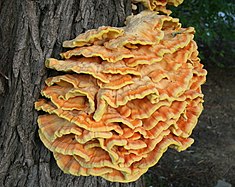Laetiporus
| Laetiporus | |
|---|---|
 |
|
| L. sulphureus in Belgium | |
| Scientific classification | |
| Kingdom: | Fungi |
| Division: | Basidiomycota |
| Class: | Agaricomycetes |
| Order: | Polyporales |
| Family: | Fomitopsidaceae |
| Genus: |
Laetiporus Murr. (1904) |
| Type species | |
|
Laetiporus speciosus Battarra ex Murrill (1904) |
|
Laetiporus is a genus of edible mushrooms found throughout much of the world. Some species, especially Laetiporus sulphureus, are commonly known as sulphur shelf, chicken of the woods, the chicken mushroom, or the chicken fungus because many think they taste like chicken. The name "chicken of the woods" is not to be confused with the edible polypore, Maitake (Grifola frondosa) known as "hen of the woods", or with Lyophyllum decastes, known as the "fried chicken mushroom".
Individual "shelves" range from 5–25 cm (2"-10" inches) across. These shelves are made up of many tiny tubular filaments (hyphae). The mushroom grows in large brackets - some have been found that weigh over 45 kg (100 pounds). It is most commonly found on wounds of trees, mostly oak, though it is also frequently found on eucalyptus, yew, sweet chestnut, and willow, as well as conifers in some species. Laetiporus species produce brown rot in the host on which they grow.
Young fruiting bodies are characterized by a moist, rubbery, sulphur-yellow to orange body sometimes with bright orange tips. Older brackets become pale and brittle almost chalk like, mildly pungent, and are often dotted with beetle or slug/woodlouse holes. Similar species include Laetiporus gilbertsonii (fluorescent pink, more amorphous) and L. coniferica (common in the western United States, especially on red fir trees). Edibility traits for the different species have not been well documented, although all are generally considered edible with caution.
The sulphur shelf mushroom sometimes comes back year after year when the weather suits its sporulation preferences. From late spring to early autumn, the sulphur shelf thrives, making it a boon to mushroom hunters and a bane to those concerned about the health of their trees. This fungus causes a brown cubical rot and embrittlement which in later stages ends in the collapse of the host tree, as it can no longer flex and bend in the wind.
...
Wikipedia
